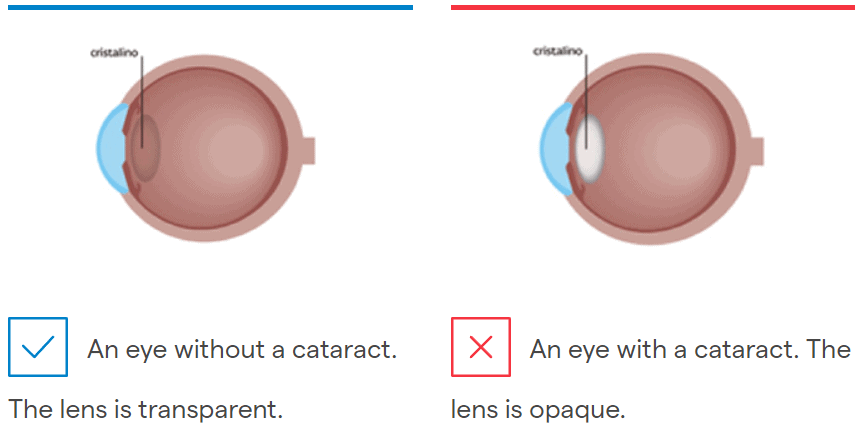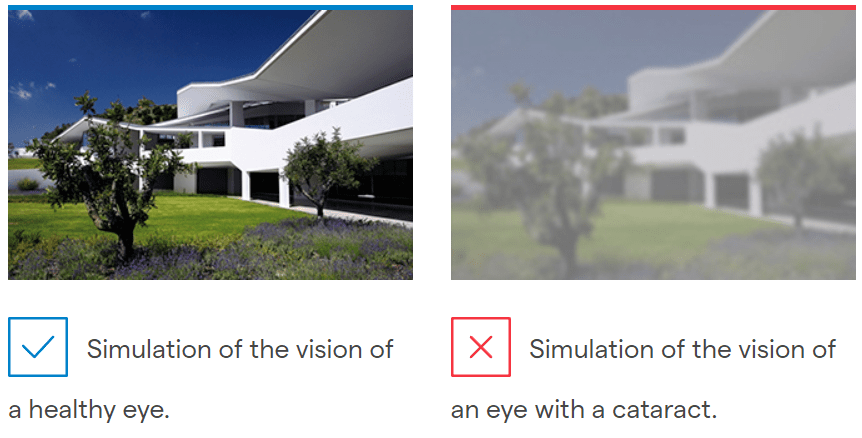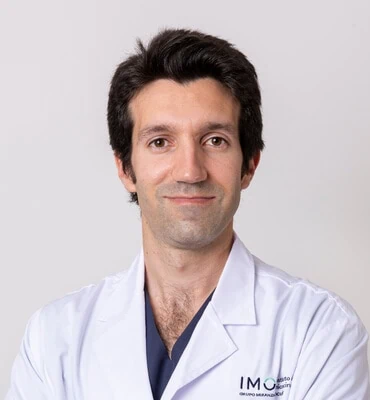What are cataracts?

Cataracts are the loss of transparency of the crystalline lens, an ocular structure that has the main characteristics:
- it is the eye’s natural lens
- it is located behind the pupil
- rays of light pass through this lens to reach the retina, where images are formed.
If the lens becomes less transparent and obstructs the passage of light to the retina, the patient suffers from a progressive loss of vision.
What causes cataracts?
As people get older, the crystalline lens becomes more opaque. Aging is the main cause of cataracts.
There are other factors unrelated to age, however, cataracts can be caused by genetic predisposition, trauma, diseases of the eye or the organism (e.g. diabetes) or the consumption of certain drugs. In some cases, a cataract is congenital, i.e. present from birth.
How can cataracts be prevented?
Cataracts cannot be prevented, but they can be detected by eye check-ups. It is advisable to see an ophthalmologist, especially after the age of 45, to detect the possible existence of a cataract, its type, size and location, and to determine whether surgery is required and when it should be carried out.
Signs and symptoms of cataracts

Depending on the size and location of opaque areas on the crystalline lens, the patient may not notice the development of a cataract.
These are some of the most common symptoms:
- Blurred and sometimes double vision when a cataract is forming
- Photophobia (sensitivity to light)
- Better vision on cloudy days than on sunny days
- Glasses are no longer required for near vision
- Driving at night becomes more difficult
- Prescription glasses need to be changed more frequently
- After the age of 50, myopia may worsen, or alternatively, eyesight may inexplicably improve. This occurs because the cataract can cause some changes to the lens, creating a magnifying glass effect
Associated treatments
Treatment of cataracts
Surgery is necessary to treat cataracts. The most common procedure is phacoemulsification, which consists of emulsifying the cataract and aspirating it. An artificial intraocular lens is then fitted to replace the content of the opaque lens. The choice of lens depends on each patient’s visual characteristics.
Cataracts’ Surgery
The procedure is quick, painless, low risk in terms of anaesthesia and easy to recover from.
Although it produces good results, it is important to remember that it does involve surgery and is therefore not without risk. Complications resulting from poor cataract surgery are the main cause of opacity in the cornea, glaucoma, retinal detachment and other conditions.
To minimise the risks of surgery, patients should put themselves in expert hands to ensure the most appropriate technique is used.
Testimonials

La mateixa tarda de la intervenció ja hi veia bé i encara avui, 17 anys després, segueixo sense utilitzar ulleres
Amèlia Petit
Barcelona
Specialists who treat this pathology
FAQs
Patients can notice small floating objects, which are capsular remains in the vitreous space, but after a few days they normally disappear. Photocoagulation with YAG laser is applied to the capsule holding the artificial intraocular lens, which over time becomes opaque, resulting in the patient losing vision. Photocoagulation with YAG laser is painless and quickly achieves visual improvement.
IMO Institute of Ocular Microsurgery
Josep María Lladó, 3
08035 Barcelona
Phone: (+34) 934 000 700
E-mail: international@imo.es
See map on Google Maps
By car
GPS navigator coordinates:
41º 24’ 38” N – 02º 07’ 29” E
Exit 7 of the Ronda de Dalt (mountain side). The clinic has a car park with more than 200 parking spaces.
By bus
Autobus H2: Rotonda de Bellesguard, parada 1540
Autobus 196: Josep Maria Lladó-Bellesguard, parada 3191
Autobuses H2, 123, 196: Ronda de Dalt – Bellesguard, parada 0071
How to arrive at IMO from:
IMO Madrid
C/ Valle de Pinares Llanos, 3
28035 Madrid
Phone: (+34) 910 783 783
See map in Google Maps
Public transport
Metro Lacoma (líne 7)
Autobuses:
- Lines 49 & 64, stop “Senda del Infante”
- Line N21, stop “Metro Lacoma”
Timetables
Patient care:
Monday to Friday, 8 a.m. to 9 p.m.
IMO Andorra
Av. de les Nacions Unides, 17
AD700 Escaldes-Engordany, Andorra
Phone: (+376) 688 55 44
See map in Google Maps
IMO Manresa
C/ Carrasco i Formiguera, 33 (Baixos)
08242 – Manresa
Tel: (+34) 938 749 160
See map in Google Maps
Public transport
FGC. Line R5 & R50 direction Manresa. Station/Stop: Baixador de Manresa
Timetables
Monday to Friday, 09:00 A.M – 07:00 PM












